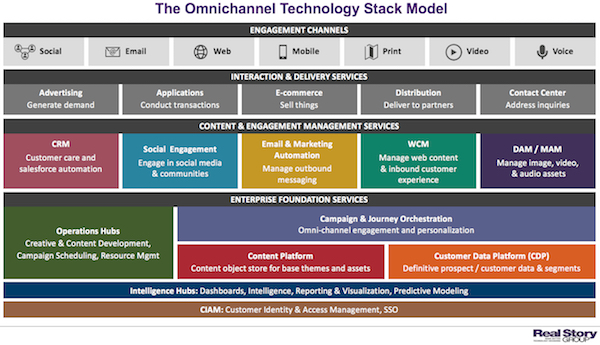The following is a guest post by Tony Byrne, founder of Real Story Group, an independent analyst firm that evaluates technology vendors and delivers hard-hitting research and advice. RSG only works on the “buy” side to advise enterprise tech decision-makers, and never works for vendors. Tony will be running a workshop and a series of presentations in the MarTech Theater at MarTech next week.
From a technology perspective, many of us focus intently on martech stacks, but the reality is that most large enterprises have evolved multiple — often overlapping — stacks across the customer experience spectrum: for marketing, sales, service & support, advertising, and web/DX.
Of course, your customers don’t care about your stacks. They expect to be able to engage coherently and consistently with you regardless of channel, and continue doing so when new channels like voice emerge.
And of course you share the same ambition. But how to get there? You face key governance, operational, and information challenges for sure, but today I’m going to focus on the technical prerequisites: specifically, what Real Story Group calls The New Omnichannel Stack.
LAST MINUTE PROMO FROM THE EDITOR: You can still snag a free Expo+ pass to MarTech conference in San Jose next week, April 3-5, to see a series of lightning talks on this topic in the MarTech Theater, presented by Tony himself.
How We Got Here
Many large enterprises have spent the last five years modernizing their customer engagement environments, solving difficult technical problems, moving with vendors to the cloud, and building sufficient levels of in-house expertise to master complex technology platforms. This process may remain incomplete at your firm, but it’s important work and critical to delivering modern digital experiences.
The problem is that we’ve been working on individual platforms and in many cases simply building stronger silos.
Most of you recognize this problem and are trying to do something about it, like aligning your inbound and outbound campaign messaging and cycles. You’re trying to get sales and marketing aligned digitally. And so on.
But there’s a problem. These sorts of bilateral connectors and coordination don’t scale across multiple channels. Internally, your teams are sending spreadsheets and calendars around to try to align data and decisioning — and it’s just not working.
An Omnichannel Reference Model
There are many things for the enterprise to address here, but we think it starts by moving key services lower in your stack. This allows for proper architectural separation of concerns and sharing capabilities and assets across existing and future channels.
A truly omnichannel stack isolates a set of what Real Story Group labels “Enterprise Foundation Services.” These are capabilities you that you abstract away from individual engagement platforms and delivery channels, to make available across the enterprise.
Note this is a reference model, and when advising individual enterprise subscribers, we typically modify it to unique circumstances. But it provides directional guidance on a target state.
Six Critical Technologies
In particular I encourage you to consider the colored boxes under Enterprise Foundation Services. Let’s start from the bottom up.
- Customer Identity and Access Management. This is foundational. Fortunately most of us are getting better at it.
- Intelligence Hubs. These are a series of hubs where you glean analytic insights. With enterprise investments in data warehouses, data lakes, an everything in-between, many firms are making progress in de-siloing this work.
- Customer Data Platforms. CDPs provide a unified view of the customer, their attributes, behaviors, segments, etc., accessible in a business user-friendly environment.
- Journey Orchestration Engines. Here’s where you make decisions about customers engaged with your enterprise: what, where, when, and how.
- Core Content Platforms. This is an emergent marketplace spinning off from Digital Asset Management (DAM), supporting channel-agnostic content and experience elements — not all your content, but the core offers, stories, elements, and assets.
- Operations Hubs. These are platforms where you support internal creation, collaboration, scheduling, measurement, and all the other operational services you may need across enterprise departments. This is a very fast-moving space right now, with a lot of vendor overlap.
These marketplaces have some attributes in common. They’re mostly emergent, highly fragmented, and in some cases only lightly covered by major martech suite vendors. In RSG’s CDP vendor evaluations, for example, we cover nearly thirty plausible players.
A Contrarian Take
There’s some conventional wisdom that a major incumbent platform in your multichannel stack can give you omnichannel capabilities. This is false. Individual technology platforms are not omnichannel. A vendor is not omnichannel. Your stack can be omnichannel.
Major martech vendors like Adobe, Salesforce, IBM, and Oracle are broadening the scope and functionality of their mid-stack management and engagement platforms to make them more multichannel in scope. When they and their industry analyst pals advise you to deepen your investments in their DAM, WCM, CRM, and MAP/ESP platforms, I believe they’re steering you wrong. If you care about omnichannel, consider investing lower in your stack — where, by the way, those incumbent cloud vendors may not be so strong today.
There’s an added bonus here: when your enterprise-wide foundation capabilities become richer, you can deploy simpler, cheaper tooling at the engagement tier, which becomes more about experience assembly, and less about managing decisions, content, and data.
Individual technology platforms are not #omnichannel. A vendor is not omnichannel. Your stack can be omnichannel.
— Tony Byrne (@TonyByrne) March 28, 2019
What You Should Do
Extracting information management and decisioning services from front-line engagement platforms and deploying as enterprise-wide capabilities is not easy. This transition is fraught, but many enterprises are already on the path. I think it starts with a roadmap for a new omnichannel tech stack.
Thanks, Tony. Looking forward to hearing your talks at MarTech next week!




